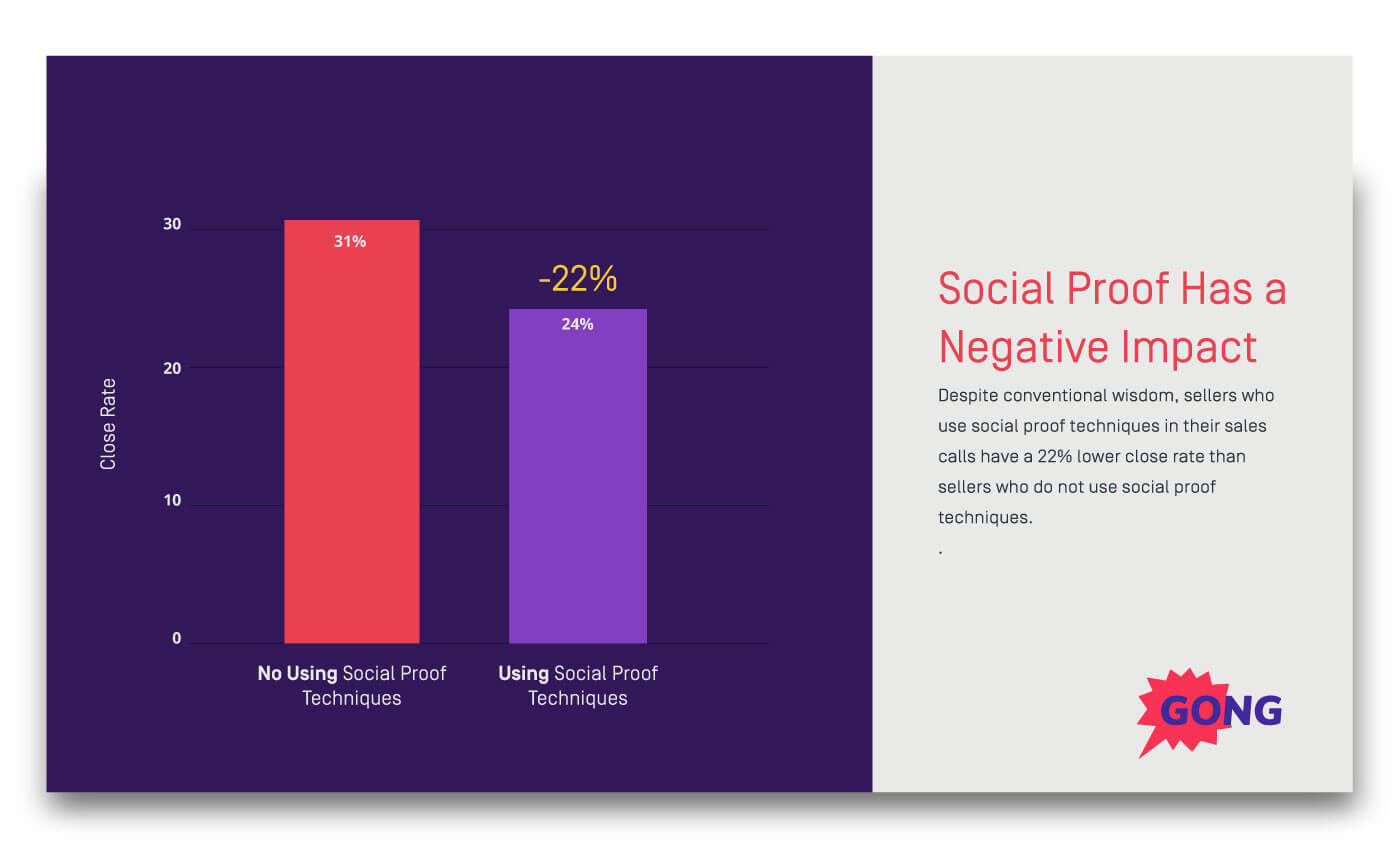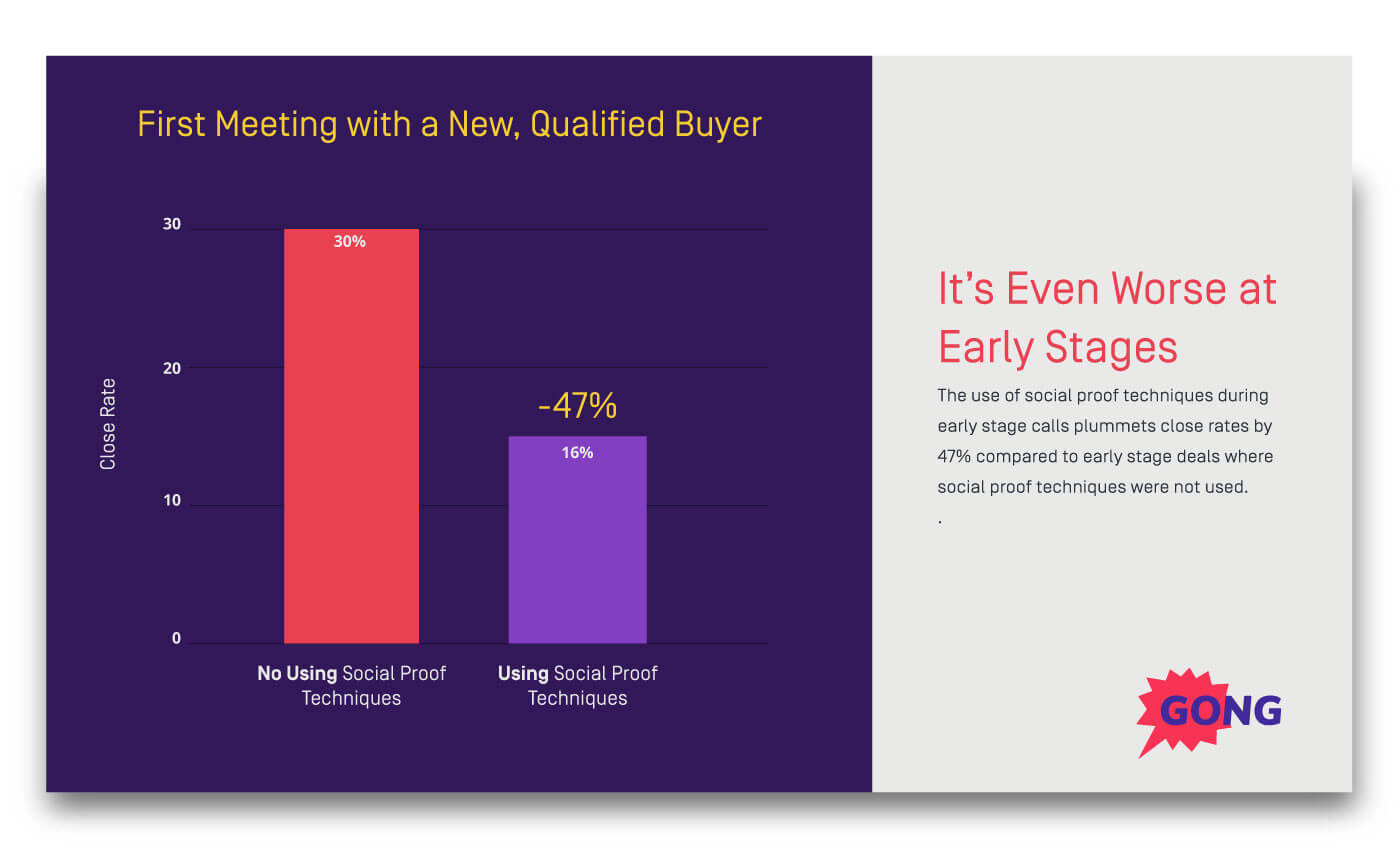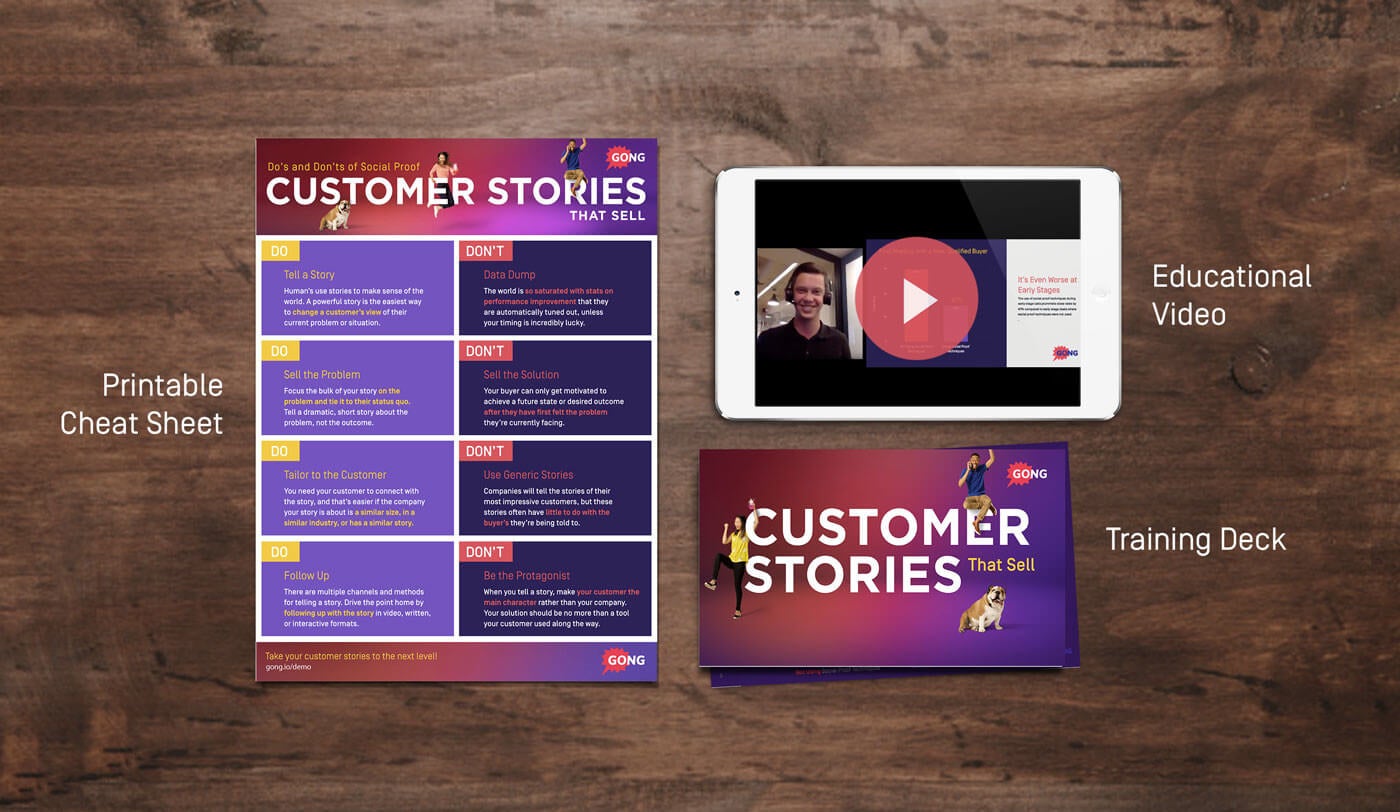The power of social proof in sales
Social proof can be one of your most powerful sales techniques. If used the right way. Many of the top sales methodologies include its use at some phase or another.
But unfortunately, it’s often misapplied. And when it’s misapplied, it creates some formidable sales objections that you’ll need to handle.
Let me walk you through a personal story that illustrates how social proof can be sloppily used.
It was March 2013, and I was in the middle of a hell-storm of a sales call.
“I don’t care if Google is your customer,” the VP barked.
“We’re nothing like them.”
The conversation had more friction than pink fingernails screeching down a chalkboard.
Everything I said irritated the VP.
But it wasn’t that way for the entire call.
The conversation went south 22 minutes in.
Right when I was pouring the social proof on thick: telling customer stories and name-dropping a few big customers.
Any textbook sales trainer would have been proud.
But in this case, not only did social proof not work, it unraveled the deal.
Weeks later, I had the shameful task of reporting that I had lost the deal to a four-person startup in a garage…
Somewhere in Cleveland.
PS: Here’s the best video on the Internet you’ll find on selling with social proof:
What Is Social Proof?
Now, before I unpack that story and explain the right and wrong ways to use social proof in sales, let me first explain what social proof is.
Social proof can be found in many areas in both online and offline sales and marketing.
The easy definition of social proof is using endorsements from other people (usually customers) to your product or business in an effort to build credibility with potential buyers.
Some examples of modern day social proof techniques include:
- Customer case studies
- Testimonials
- Influencer endorsements
- Customers logos plastered on your website or slide deck
- Customer references
The goal of most of these social proof techniques is to create a bandwagon effect: Everyone is jumping on board, so you may as well too!
Social Proof Kills Deals (When Used Wrong)
It turns out, using social proof in sales is like playing with fire.
Its misuse dramatically increases your odds of losing deals.
Here’s the data behind that.
Our data science team looked at 48,006 B2B sales deals recorded on web conferencing platforms.
Every call in their sales process was transcribed, speaker-separated, and analyzed with AI.
We identified the use of social proof techniques, such as:
- Telling customer stories
- Name-dropping customers
And other social proof techniques sellers use to build credibility by highlighting current customers.
The analysis of each call looked something like this:

The results melted my brain:
- Sellers who use social proof techniques in their sales calls have a 22% lower close rate (in general):

It gets worse.
This effect multiplies during the first meeting with a new, qualified buyer:
The use of social proof techniques during early stage calls plummets eventual close rates by 47%:

Most sales professionals know that social proof is a “weapon of influence.”
So what’s going on here?
It’s pretty simple:
Social proof is spectacularly misapplied in sales.
Most salespeople are right to deploy this “weapon of influence,” but they wield it poorly.
(Want to skip ahead? Download our university-grade training course: How to Use Social Proof That Sells by clicking the banner below)”
Why Social Proof Unravels Deals
Humans belong to tribes.
We identify with other groups of people that have a bonding commonality.
For example, I live in San Mateo, work in SaaS, and deal with the daily challenge of raising two toddlers.
When I meet people with any of those circumstances, we bond at some level.
Your buyers are no different.
They must feel that they belong to the same tribe as the customers you mention during your social proof techniques.
Otherwise, social proof backfires.
When you’re telling a customer story, your buyer will think “Are they like me?”
If they’re not, your buyer concludes:
“This product is for people like that, but I’m like this. Not for me .”
Your well-intentioned social proof will alienate your buyers.
So if generic social proof creates friction and alienates buyers, what’s the solution?
Tribal social proof.
Tribal Social Proof: Your Key to Success
Tribal social proof is when you talk about your customers in a way that makes your prospects think:
“Those guys sound like me. They dealt with the same punishing world I’m dealing with.”
Your buyer feels they are in the same tribe as your customer.
When your social proof triggers that effect, the world is your oyster.
I have two social proof techniques that will help you generate this effect.
Social Proof Technique 1: The Tribal Stampede
The first is what I call the “tribal stampede.”
The effect you’re aiming for is to give the impression that your buyer’s entire tribe is stampeding toward your solution.
How do you do that?
By rattling off an impressive list (5-7) customers your buyer identifies with.
- Any average sales rep can rattle off 2-3 big-name customers.
- Any good sales rep can rattle off 2-3 “same-tribe” customers.
- But only the best can rattle off half a dozen customers that your prospect connects with.
When you rattle off more than five names, the message you send is “everyone like you is jumping on board.”
Done right, it creates a powerful motivational force that’s hard to resist.
Social Proof Technique 2: Customer Stories That Resonate
What if you don’t have a unified group of customers in the same tribe (i.e., industry) as your buyer?
Here’s where the second technique (storytelling) becomes your secret weapon.
You can get away with name-dropping customers in a different industry (tribe) under one condition:
- The story of your customer’s problem resonates with your buyer.
You may want to write this on a sticky note:
If you can describe the buyer’s problem better than they can themselves, they will automatically assume you have the best solution.
A targeted customer story is the best way to do that.
Your buyers will see themselves in your stories, and come to their own “self-discovery.”
They will feel connected despite being in a different industry from your customer.
And your deal will be in the bag.
This runs counter to how most sales professionals tell customer stories. They “data dump” the results the customer achieved, skipping the “problem” part of the story.
You need to do both. And that’s tougher than you think.
Social Proof That Sells Master Class
There are more wrong ways to use social proof than there are right ways.
If you get it wrong, you’ll get burned. If you get it right, it’s like bringing a flamethrower to a stick fight. Your competitors won’t stand a chance.
That’s why we built a university-grade training course on how to use social proof (and tell customer stories) that sells.

If you’re in sales leadership, this is powerful training material for your team.
If you’re a rep, this will take your income to the next level.
In this FREE social proof course, you’ll receive:
- A 27-minute video on how to tell customer stories that close
- A rich list of tips and tactics for selling with social proof
- A printable cheat sheet to make what you learned stick
